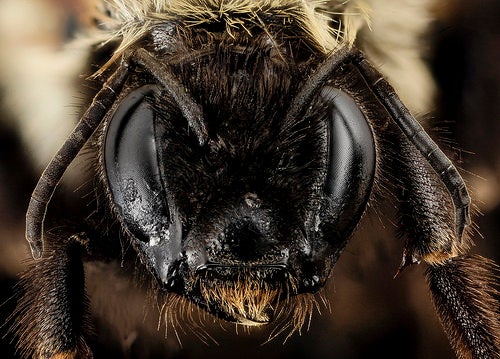Rusty-Patched Bumble Bee Discovered
The rusty-patched bumble bee (Bombus affinis), which has not been seen in the eastern United States in five years, has been found by a Smithsonian Conservation Biology Institute research team at Sky Meadows State Park in Delaplane, Virginia. This formerly common bee has disappeared from 87 percent of its range in the Upper Midwest and Eastern Seaboard and is feared headed for extinction.
The research team, led by Bill McShea and Tom Akre of the Smithsonian Conservation Biology Institute and T'ai Roulston from the University of Virginia, surveyed bee populations at 17 Virginia sites from May through August to study the influence of land management on bee diversity. Only one individual of this now rare species was found among nearly 35,000 bees belonging to 126 species collected and examined by the study. The study is part of Virginia Working Landscapes, a collaborative research program aimed at discovering effective ways private landholders can practice biodiversity management.
"We thought this bumble bee was extinct in this region," McShea said. "Finding one bee, well this is the stuff conservationists live for. The decline of bee species is of great conservation concern and scientists are actively investigating potential causes to figure out what the culprit is. If we lose bees, we lose critically important pollinators."
Nearly 70 percent of all flowering plants reproduce due to pollination by bees and other pollinators. In fact, about one third of the human food supply depends on insect pollination, most of which is accomplished by bees. Beyond agriculture, pollinators are keystone species in most terrestrial ecosystems. Fruits and seeds derived from insect pollination are a major part of the diet of approximately a quarter of all birds and mammals. However, many native bee pollinators are at risk due to habitat loss and fragmentation, climate change, pesticide use and introduced disease; and the status of many other species of native bee pollinators is unknown.
"In 20 years of studying bees, I have never seen a rusty-patched," said Roulston. "Where there is a worker bee, there is a colony and maybe more than one. As they've gone underground for the winter, we can actively look for the colony next spring, and study them and what might be affecting the species. We've either found rusty-patched bumble bees that have developed a resistance or we've discovered one of the last colonies and will get one more glimpse before they disappear forever."
The cause of the rusty-patched bumble bee's decline is not known for certain, but may be related to the accidental introduction of a virulent European fungus (Nosema bombi). Because the rusty-patched bumble bee is now so rare, there has been little opportunity to study what affects its populations. The fungus has been implicated in the sudden decline of several other species of bumble bee across the United States, including the American bumble bee (B. pensylvanicus), which the research team found at four private landowner sites during its surveys.
The rusty-patched bumble bee workers can be identified by a small rust-colored patch on the middle of their second abdominal segment. A number of surveys have been done across its historic range, but the rusty-patched bumble bee has not been found in most of its range since 2003.
In the case of this bee, the volunteer naturalists collected the specimens that were sorted and identified by University of Virginia staff based at Blandy Experimental Farm.
This research is part of Virginia Working Landscapes, a broad collaboration between the Smithsonian Conservation Biology Institute, government agencies and NGOs, and a consortium of landowners and citizen scientists. Virginia Working Landscapes links landowners interested in restoring or maintaining habitat with appropriate land management agencies and provides survey results so landowners can track their progress. The surveys are conducted in large part by citizen scientists from regional or state organizations, such as Virginia Master Naturalists, Virginia Native Plant Society and the National Audubon Society.
Virginia Working Landscapes is just one example of programs that involve citizen scientists in the collection of data for scientists studying wildlife. Concerned citizens who want to take action and help track and conserve North America's bumble bees can participate in the Bumble Bee Watch. This collaborative project, led by the Xerces Society, allows participants to upload photos, use an interactive identification tool and submit geo-referenced records that will be used by scientists to follow these essential pollinators and inform effective conservation actions.
The specimen will become part of the Smithsonian National Museum of Natural History's entomology collection.
